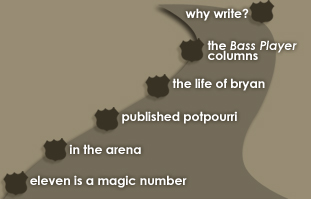
 |
|||||||||
|
|
|||||||||
| Sign up for BellerBytes, the official (and private) Bryan Beller e-newsletter. Just click here to sign up. Do it, OK? | |||||||||
|
Column
#17: That Studio Magic You'd think we bassists are well suited for such an exercise. We're not in this for the social opportunities, unlike some of our guitarist and drummer friends. We're the glue between the rhythm and the harmony. We get to the gig on time, set up our gear, make sure the EQ settings are right, actually tune our instruments - of course we take this stuff seriously. So why is it that when we first try to duplicate our live sound in the studio, we feel like teenagers fumbling around at night in the backseat, with the engineer acting as our unhappy partner, shooting us glares easily interpreted as "that's not it"? (Yes, it's possible I'm projecting at this point, but stay with me.) Getting a sound to tape separates the bassist from the band in a different way. Guitarists can just mike their amp; keyboardists are meant to patch straight into a console; getting drum sounds in the studio is a long-standing black art. The first thing that we hear is the sound of our bass going direct into the mixing board. I don't know about you, but the first time I heard my direct bass sound "soloed" in the middle of a track, I retched. What's all that buzzing? Why am I playing some notes harder than others? Why did the drummer make my time sound so uneven? (What do you mean, he was on with the click?) There was something about being onstage, with my rig behind me and the club's subwoofers beneath me, that made my bass sound really good. Now I'm in this glorified closet, the room's as dry as a Denny's steak, and I have to reproduce that big sound somehow. The first few times were tough. Engineers would look at me in that smarmy way and ask, "Is that the sound you want?" Yes, Mr. Button-Pusher, I really do want my bass to sound like bovine flatulence. Thanks for asking. Eventually I did a session where an engineer brought his own, custom-made-in-someone's-garage tube direct box, and it made my bass sound like God. So I went out and bought my own for 800 bucks, only to find out that the real tonal magic was from that studio's 48" monitors, not from God's Direct Box, which I sold online at a 75% loss. My first step on the road to studio sanity came via instrument choice. My main axe, which sounded so wonderful live, sounded rough going direct no matter what I ran it through. I went to an instrument with greater dynamic range and a setup that fought me a little less than I was used to, and suddenly sweetness and clarity appeared. Ah, that's better. Only now it sounded a little small. "Why not run a second channel with a little combo amp," an unusually helpful engineer asked me. "Add some extra air and bottom to it." You mean, I can have some control over the EQ? Really? Next time I showed up with a nice 2x10 combo and a trick outboard EQ. Words cannot describe my excitement as I set the controls to my liking and then watched the assistant engineer mike the cab. Things started making sense to me. What was it that I liked about my sound onstage, anyway? Well, I was sending a completely direct signal to the house mixer, so it had to be the direct sound amplified throughout the house, right? But from where I was standing onstage, that was only an ambient backdrop to what was coming out of my rig, which was blending in with the house sound differently in every room I played. The more I thought about it, the more I realized that I wasn't trying to reproduce anything. I was creating a studio sound, actually building a tone from the ground up. This was real; live sound was psychoacoustic in ways I hadn't fully realized. And like I said, it's not like a guitar amp, where the sound coming out of the speakers is the sound, period, and you just mike it. With bass, you start with the direct signal; it's what you add on (or what you don't) that really counts. In this case, after tweaking the EQ and blending the two signals (amp and direct) I got a full, clear, unique sound, closer to what I'd always wanted than at any time before. (Tip: Add a little more high end than you think you need. It may sound clicky by itself, but once the mix is done, often it's the difference between hearing the little things or not. And during mixing, they can always reduce the high end, but they can never add it in a natural fashion if it's not there to begin with.) My last step to enlightenment came when An Important Guy called me for a session, a infrequent occurrence in my live-heavy job history. Just as I was feeling all professional about what gear I would bring, he said none would be necessary - everything was set up already, so just be there in five hours. I stammered "okay" and hung up, imagining what kind of faces I could expect from the engineer this time around. Instead, I found my bass split into three channels: one direct, one through a clean rig and miked, and another through a digitally simulated "dirty" rig. The dirty sound added a hairy bite to the tone and was downright nasty on its own, but when blended in, it provided just the right counterweight to the clean rig's smiley-face EQ. I had to refrain from spontaneous jubilation in the control room, lest the Important Guy think I was some kind of amateur. (No snickering, please.) I didn't care for the kind of distortion used on that session, but the three-channel idea stuck with me. It now gives me control over each of the two sounds (clean and dirty) I add on to the direct. Sometimes I listen back and say to myself, "Man, that sounds just like my live sound!" Then I reminded myself: under the right circumstances, the "live sound" I always liked really sounds like this. Of course, that's just what works for me. Some players get a great sound going direct. With the right outboard studio gear, anything's possible. Others swear by miking gigantic rigs. The latest digital modeling platform probably has a patch called God's Direct Box, and I'll bet it doesn't sound half bad. When a specific sound is required, all the rules can go out the window. All I'm saying is, what works for you live won't necessarily work in the studio. Take a little time, find out what that perfect sound in your head really sounds like, and then emulate it through trial and error - with a likely emphasis on the latter - until you've got the goods on tape. Then you can bathe in the confidence that your contribution to "the magic" will be a secure transaction. Especially with that Pro Tools whiz standing by. By Bryan
Beller, copyright 2002 United Entertainment Media. Reprinted from the
October, 2002 issue of BASS PLAYER. Reprinted with permission from BASS
PLAYER. For subscription information, please call (850) 682-7644 or
visit www.bassplayer.com |

|